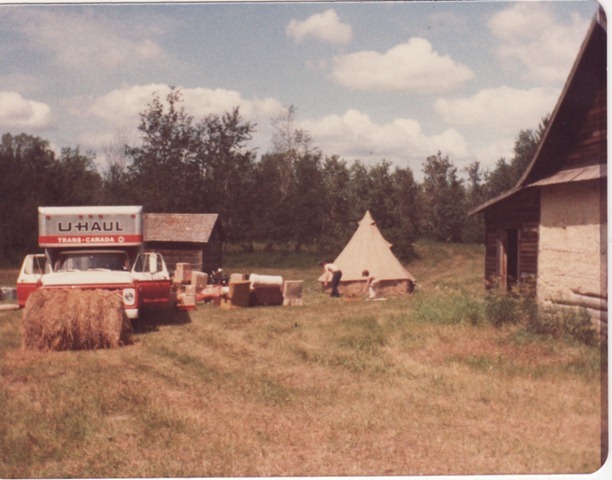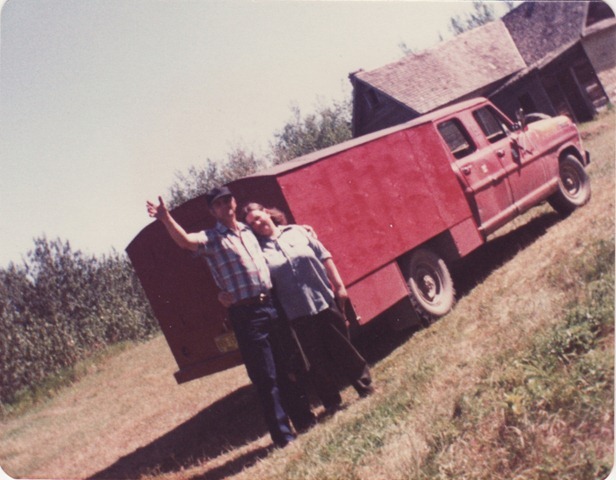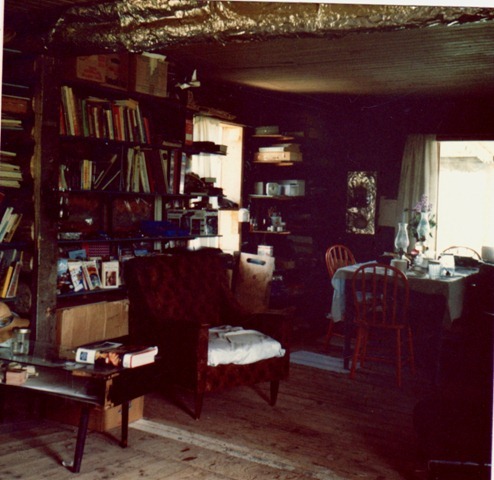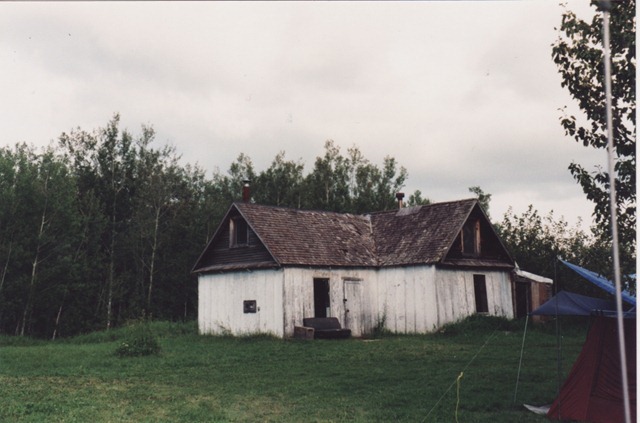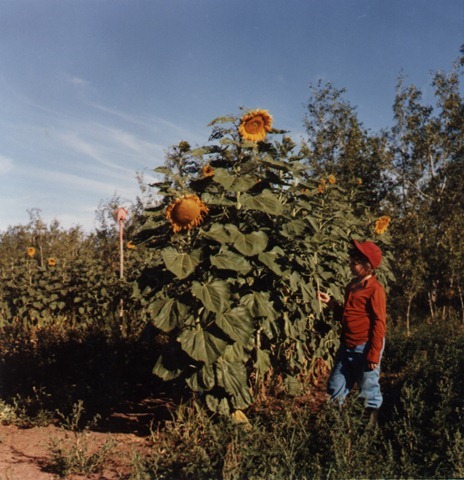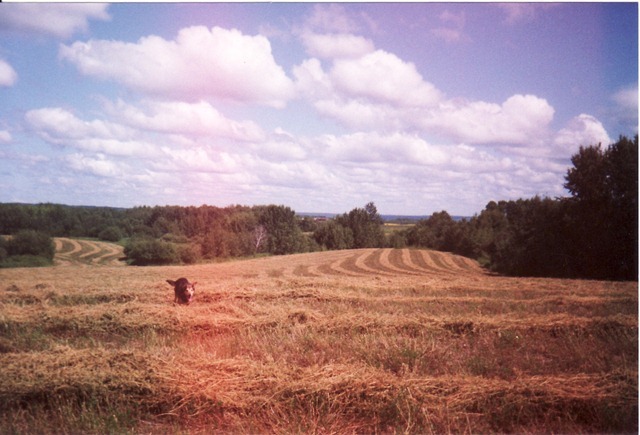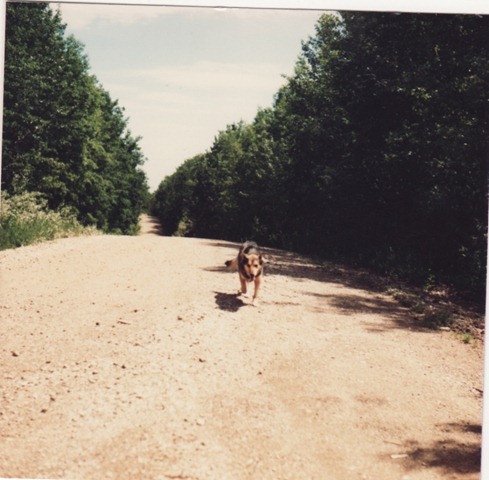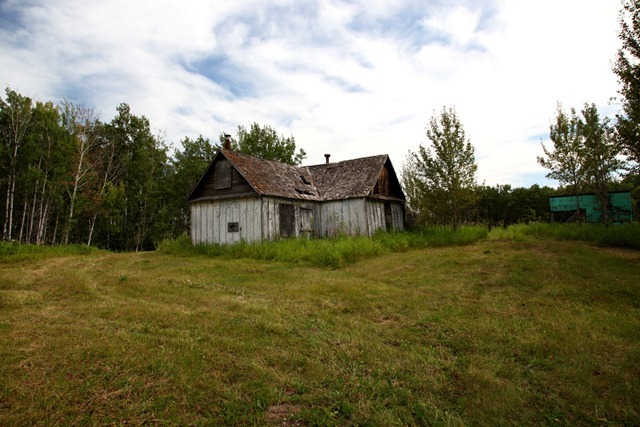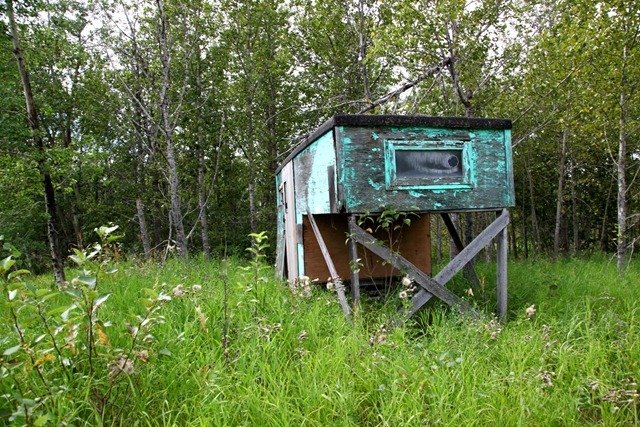The Farm
2011/08/15
As previously mentioned, in 1982 we bought and moved to an 80-acre plot of land near Angusville, Manitoba.
Roughly half of it is covered by poplar trees, 10% by marshland and the remainder is cleared and arable. There is a ~hundred-year-old log cabin with a small shed at the northwest corner. When we arrived, the house was formatted as three small rooms downstairs and two in the attic, and was insulated with a mixture of mud, manure and straw. There were barn swallows nesting inside since there was no glass left in any of the windows.
We moved in one trip using the largest U-Haul truck available. Here’s us unpacking – you can see the original state of the house to the side:
Remember when I mentioned the nice wooden camper my father made in an earlier post? He made it modular, so it could be removed from the truck and replaced with something else. So we took the camper off and made it a permanent fixture of the lot, and used it to sleep in while making the main house liveable. My father built a new cargo box for the truck:
We knocked out all that mud insulation and put in Fiberglas, and put plywood around the outside to block the wind, and glass in the windows. We also knocked out all the inside walls to make it just two big rooms – one downstairs and one upstairs. Roof leaks were repaired, telephone installed (at great cost) and a wood stove bought at action and installed. Then it was mostly livable. Here’s the furnished interior after all that:
Keep in mind that we had no running water – we couldn’t afford to have a well professionally drilled, and our attempt to dig our own was fruitless. No electricity either, and the phone was a party line, shared with two neighbors; the rings were coded to identify the recipients of calls, which meant we all knew when someone else was getting a call, and when making a call we had to check that the line was clear first. Heat was from the wood stove. Light from oil lamps, a Coleman kerosene camping lantern, and one electric light run off a car battery and recharged in the truck every few days. Oh, and we never completely eliminated the occasional mouse getting inside – and in the summer, sometimes even the odd garter snake. The cat loved those – automatic strings!
We brought drinking water in from Rossburn in five-gallon pails. Bathing was done by pouring water over oneself by cup-fulls while standing in a kiddie pool, and the toilet was a pail with a seat on it that had to be emptied every few days.
Reading by oil lamp has its charm, but its perils too – in the summer the attic sleeping area would have dozens of brown moths making their kamikaze attacks on the lamps, occasionally even succeeding in damping the flame through noble sacrifice. While the roof was waterproof it wasn’t moth-proof. Eventually I set up a small camping tent inside the attic, put my bed inside, and read with just my head and arms sticking out of the zipper. That actually worked really well. It was also nice because my father installed larger windows upstairs and at night I could lay in bed looking out and up at the stars. The night skies here are fantastic.
As are the summer thunderstorms. Sometimes it was like having giants pounding on the roof. Proper storms are something I really miss in Vancouver; they almost never occur there.
We listened to either music or CBC radio all the time. Peter Gzowski, Arthur Black and Lister Sinclair are the voices of Canada for me.
Here’s what the exterior of the house looked like after the renovations:
Note the second chimney. My favorite story about this place concerns the single winter we stayed here. On Christmas morning it was -50c outside, -30c inside, and we woke up with icicles where our breath had landed during the night. I spent much of that Christmas with my winter-booted feet in the oven to warm them.
So we installed an oil drum furnace and made part of the downstairs floor concrete to retain the heat. That worked really well, but it meant we were burning that much more wood. Poplar grows like a weed, but it’s still a lot of work to cut and chop it.
My father also built a greenhouse on the south side of the house so we could grow vegetables earlier and later in the year, and my mother and I had gardens in the yard. I was particularly proud of my sunflowers, the tallest of which eventually reached almost 14 feet.
Roughly in the middle of the property on the east field, there is a rise. Our plan was to build a new house here. It would have had this view to the east:
However, it turned out that there was very little work for my father in the area, and money was always very tight. This plan never materialized, and eventually we went elsewhere looking for work – one winter to Winnipeg, and the next year to Toronto, where things worked out a bit better.
Oh, that’s Sporty bounding through the cut alfalfa in that photo. I mentioned in a previous post that I would give his origin story.
Sporty was originally the dog of a neighbor in this area whose name I don’t recall. That person had trained him as a hunting dog, but was abusive towards him. He was then adopted by the closer-by Olynyk family, whom we often visited, but there was competition from stronger dogs there and he wasn’t getting his share of the food.
So, presumably at the recommendation of my dog Coal, one day Sporty jumped ship and signed on with our crew. Gave us a start too – it was a semi-blizzard and we were out for a walk on the road, when we saw a canine shape trotting over the hill behind us. Thinking it a hungry wolf, we picked up the pace but he eventually caught up. Imagine this scene, but with a blizzard reducing visibility drastically:
It wasn’t until he was about this close that we recognized him, with relief. He stayed with us from then on, and would happily see us off to town by chasing the truck at great speed until he got winded, and gave us equally enthusiastic welcome-homes.
There are tons more stories about this place, but some other time.
Now, to the present. Here’s the state of the house and camper now:
Some animals (probably lynx or raccoons) have broken into the house through the roof and destroyed everything inside, leaving piles of shit everywhere. The camper I’m surprised is still standing – ants had already hollowed out the wood a while back. There are huge ant colonies in this area. I was afraid to try going inside the house – better to come back another time with automatic weapons and hazmat suits.
I got a good feeling of closure from visiting the farm again. I really like the property itself – it has a nice mixture of trees, clearings and ponds, and nice rolling hills that give it some variety. It’s a really nice piece of land, but the location is not. The region and the towns here have nothing to offer me anymore. I’d rather have this piece of land closer to a major city – I’m not sure I would even want to come here on vacation if there were a nice house on the property.
So: I have lots of fond memories of this place and the area, but they’re memories from my adolescence. The things that made the place fun for me then are no longer here, and the area has nothing to offer my adult self. I’m glad I did this, because it has eliminated an uncertainty.
